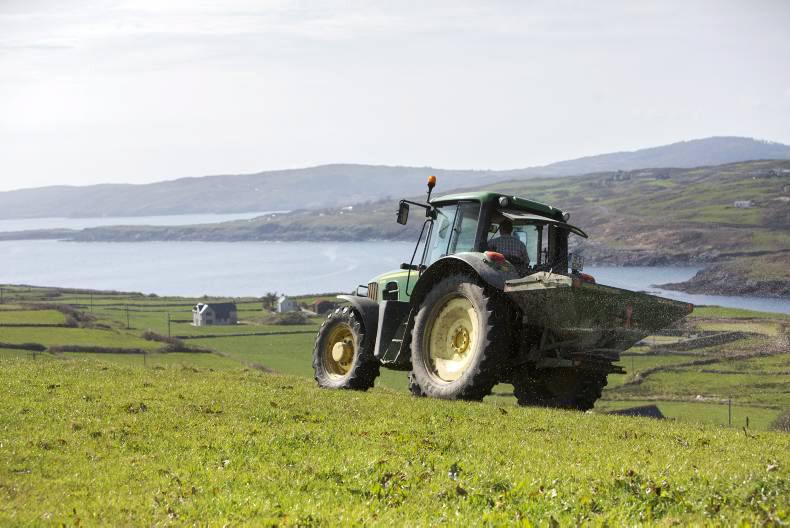According to the HSA, tractors and machinery account for the highest proportion of farm deaths and accidents each year, with the victims not only operators, but also people in the general vicinity. Tractors are an essential tool on any farm, but must be treated with respect and operated correctly
Maintenance
One of the most important points in relation to tractor safety is good maintenance. A well-maintained and looked-after tractor will reduce the risks imposed on the operator greatly.
The tractor must be fitted with a cab or safety frame that conforms to the Organisation for Economic Co-operation and Development (OECD) standards in order to protect the operator in the event of a rollover. Cabs on older tractors must be closely examined for signs of rust or corrosion which may reduce the structural strength.
Ensure the tractor can be both started and stopped in the cab by the key or a pull stop; never cross-start a tractor at the starter.
Make sure the controls inside the cab are all working correctly and are clearly labelled. Brakes should be checked regularly to ensure they are working properly, balanced and kept interlocked. Only during field work should the brakes be unlocked. The handbrake must be checked regularly, adjusted and functioning correctly.
The PTO must be able to be turned on and off from inside the cab and the correct safety guards must be in place and operational. All the tractor’s components must be maintained correctly, including the steering, hydraulics, guards, hitches and linkages, paying close attention to leaks, wear and potential problems.
The tractor itself should be cleaned regularly. Inside the cab must be kept uncluttered and free of items on the floor. These may roll under the pedals, which can cause an accident.
The windows should be kept clean to help visibility and all lights should also be kept in good working order. The heater must be functioning in order to keep the operator warm, as well as helping to defrost the windows and keep them clear. The window wipers must also be working correctly and maintained to keep the windows clear when raining.
Attaching implements
A tractor is a versatile piece of equipment due to the fact numerous different implements can be attached to it on both the front and rear in order to carry out various jobs.
Never leave the driver’s seat with the engine running. If leaving the cab, you must follow the safe stop procedure:
Bring the tractor to a stop, in a safe place and on level ground.Apply the handbrake.Disengage the transmission.Lower the implements to the ground.Turn the engine off.Remove the key.Dismount the tractor using the steps and handrails provided.Only when you have completed this procedure can you safely attach any implements. Never enter the danger zone between the back wheels and the implement when the tractor is running, as this is a potential crush area.
When attaching implements, pay attention to connection points, PTO and hydraulic for signs of potential hazards and ensure all required safety systems are in place.
Always fit the implements according to the manufacturer’s instructions and only to the draw bar or mounting points provided. Never alter, modify or raise the height of the draw bar or mounting points and regularly check that all safety pins are in place and functioning correctly.
Driving
Before driving any tractor, the operator must be capable and confident, as well as having received the appropriate training and instructions to do so.
An untrained operator can be potentially deadly behind the wheel of a tractor due to its size and weight. The operator must be dressed with the correct PPE, be aware of the risks and dangers involved and be able to apply their full attention and concentration to the job at hand. Take short breaks regularly when working long hours to reduce fatigue and help keep up full concentration.
Always drive at speeds slow enough to allow you retain control in the event of something unexpected happening. Always reduce your speed before applying the brakes or turning and always engage the clutch gently, especially when going uphill or towing.
If you are driving on slopes, carefully assess the risk of overturning before commencing and make sure you are familiar with the slope by walking it before driving. Always assess the slope and ground conditions before commencing work and consider if it is worth taking the risk.
Always use a four-wheel-drive tractor for the extra traction, weight and braking power. Select the right gear before approaching the slope and never change gear on the slope if possible.
Keep as much weight as possible uphill and if turning across a slope, always turn uphill, avoiding quick, sharp turns. When travelling down a slope, use a low gear in conjunction with the engine braking to retain speed and control. If a tractor is about to overturn, do not attempt to jump clear. Stay in the cab and hold on to the steering wheel.
Arthur Byrne, Public Safety Manager, ESB Networks
Steer clear of
electricity
poles – it could save your life
Arthur’s top tips
Always be alert to where poles and stays are; this is especially important when it can be hard to see the stay.Driving too close to poles and stays leaves no room for manoeuvre if the unexpected happens.Never drive under electricity wires with a high load unless there is at least a 3 metre safety gap.Never drive over or handle fallen electricity wires; they are always live and extremely dangerous.If an accident occurs and the electricity cables fall on to the tractor, if it is possible to safely reverse the vehicle and you can see that the wires are not tangled, then do so. If not, stay in the cab as this is the safest place to be due to the fact that the rubber tyres act as an insulator.Call the ESB emergency phone number immediately on 1850 372 999. This will alert the ESB so that staff can be dispatched immediately to make the situation safe. Please store this number in your phone for these emergency situations.To exit the tractor, jump clear of it landing on both feet. Make sure that you do not touch anything in the cab. If you touch the cab, you are bypassing the protection of the rubber tyres and will get an electric shock. Once out of the tractor, move away immediately using short steps or bunny hop with both feet together. If you take longer steps, you will receive an electric shock due to the fact that there is electricity in the ground that radiates out from the vehicle in concentric circles. This electricity decreases as you move away from the vehicle until it becomes practically negligible at about 10 metres. However, it will not disappear until the electricity is disconnected by ESB Networks.Stay clear of the area and make sure other people also do so, do not return to the tractor until ESB Networks staff tells you that it is safe to do so.
Read more
Special focus: tractors 2016
According to the HSA, tractors and machinery account for the highest proportion of farm deaths and accidents each year, with the victims not only operators, but also people in the general vicinity. Tractors are an essential tool on any farm, but must be treated with respect and operated correctly
Maintenance
One of the most important points in relation to tractor safety is good maintenance. A well-maintained and looked-after tractor will reduce the risks imposed on the operator greatly.
The tractor must be fitted with a cab or safety frame that conforms to the Organisation for Economic Co-operation and Development (OECD) standards in order to protect the operator in the event of a rollover. Cabs on older tractors must be closely examined for signs of rust or corrosion which may reduce the structural strength.
Ensure the tractor can be both started and stopped in the cab by the key or a pull stop; never cross-start a tractor at the starter.
Make sure the controls inside the cab are all working correctly and are clearly labelled. Brakes should be checked regularly to ensure they are working properly, balanced and kept interlocked. Only during field work should the brakes be unlocked. The handbrake must be checked regularly, adjusted and functioning correctly.
The PTO must be able to be turned on and off from inside the cab and the correct safety guards must be in place and operational. All the tractor’s components must be maintained correctly, including the steering, hydraulics, guards, hitches and linkages, paying close attention to leaks, wear and potential problems.
The tractor itself should be cleaned regularly. Inside the cab must be kept uncluttered and free of items on the floor. These may roll under the pedals, which can cause an accident.
The windows should be kept clean to help visibility and all lights should also be kept in good working order. The heater must be functioning in order to keep the operator warm, as well as helping to defrost the windows and keep them clear. The window wipers must also be working correctly and maintained to keep the windows clear when raining.
Attaching implements
A tractor is a versatile piece of equipment due to the fact numerous different implements can be attached to it on both the front and rear in order to carry out various jobs.
Never leave the driver’s seat with the engine running. If leaving the cab, you must follow the safe stop procedure:
Bring the tractor to a stop, in a safe place and on level ground.Apply the handbrake.Disengage the transmission.Lower the implements to the ground.Turn the engine off.Remove the key.Dismount the tractor using the steps and handrails provided.Only when you have completed this procedure can you safely attach any implements. Never enter the danger zone between the back wheels and the implement when the tractor is running, as this is a potential crush area.
When attaching implements, pay attention to connection points, PTO and hydraulic for signs of potential hazards and ensure all required safety systems are in place.
Always fit the implements according to the manufacturer’s instructions and only to the draw bar or mounting points provided. Never alter, modify or raise the height of the draw bar or mounting points and regularly check that all safety pins are in place and functioning correctly.
Driving
Before driving any tractor, the operator must be capable and confident, as well as having received the appropriate training and instructions to do so.
An untrained operator can be potentially deadly behind the wheel of a tractor due to its size and weight. The operator must be dressed with the correct PPE, be aware of the risks and dangers involved and be able to apply their full attention and concentration to the job at hand. Take short breaks regularly when working long hours to reduce fatigue and help keep up full concentration.
Always drive at speeds slow enough to allow you retain control in the event of something unexpected happening. Always reduce your speed before applying the brakes or turning and always engage the clutch gently, especially when going uphill or towing.
If you are driving on slopes, carefully assess the risk of overturning before commencing and make sure you are familiar with the slope by walking it before driving. Always assess the slope and ground conditions before commencing work and consider if it is worth taking the risk.
Always use a four-wheel-drive tractor for the extra traction, weight and braking power. Select the right gear before approaching the slope and never change gear on the slope if possible.
Keep as much weight as possible uphill and if turning across a slope, always turn uphill, avoiding quick, sharp turns. When travelling down a slope, use a low gear in conjunction with the engine braking to retain speed and control. If a tractor is about to overturn, do not attempt to jump clear. Stay in the cab and hold on to the steering wheel.
Arthur Byrne, Public Safety Manager, ESB Networks
Steer clear of
electricity
poles – it could save your life
Arthur’s top tips
Always be alert to where poles and stays are; this is especially important when it can be hard to see the stay.Driving too close to poles and stays leaves no room for manoeuvre if the unexpected happens.Never drive under electricity wires with a high load unless there is at least a 3 metre safety gap.Never drive over or handle fallen electricity wires; they are always live and extremely dangerous.If an accident occurs and the electricity cables fall on to the tractor, if it is possible to safely reverse the vehicle and you can see that the wires are not tangled, then do so. If not, stay in the cab as this is the safest place to be due to the fact that the rubber tyres act as an insulator.Call the ESB emergency phone number immediately on 1850 372 999. This will alert the ESB so that staff can be dispatched immediately to make the situation safe. Please store this number in your phone for these emergency situations.To exit the tractor, jump clear of it landing on both feet. Make sure that you do not touch anything in the cab. If you touch the cab, you are bypassing the protection of the rubber tyres and will get an electric shock. Once out of the tractor, move away immediately using short steps or bunny hop with both feet together. If you take longer steps, you will receive an electric shock due to the fact that there is electricity in the ground that radiates out from the vehicle in concentric circles. This electricity decreases as you move away from the vehicle until it becomes practically negligible at about 10 metres. However, it will not disappear until the electricity is disconnected by ESB Networks.Stay clear of the area and make sure other people also do so, do not return to the tractor until ESB Networks staff tells you that it is safe to do so.
Read more
Special focus: tractors 2016









SHARING OPTIONS